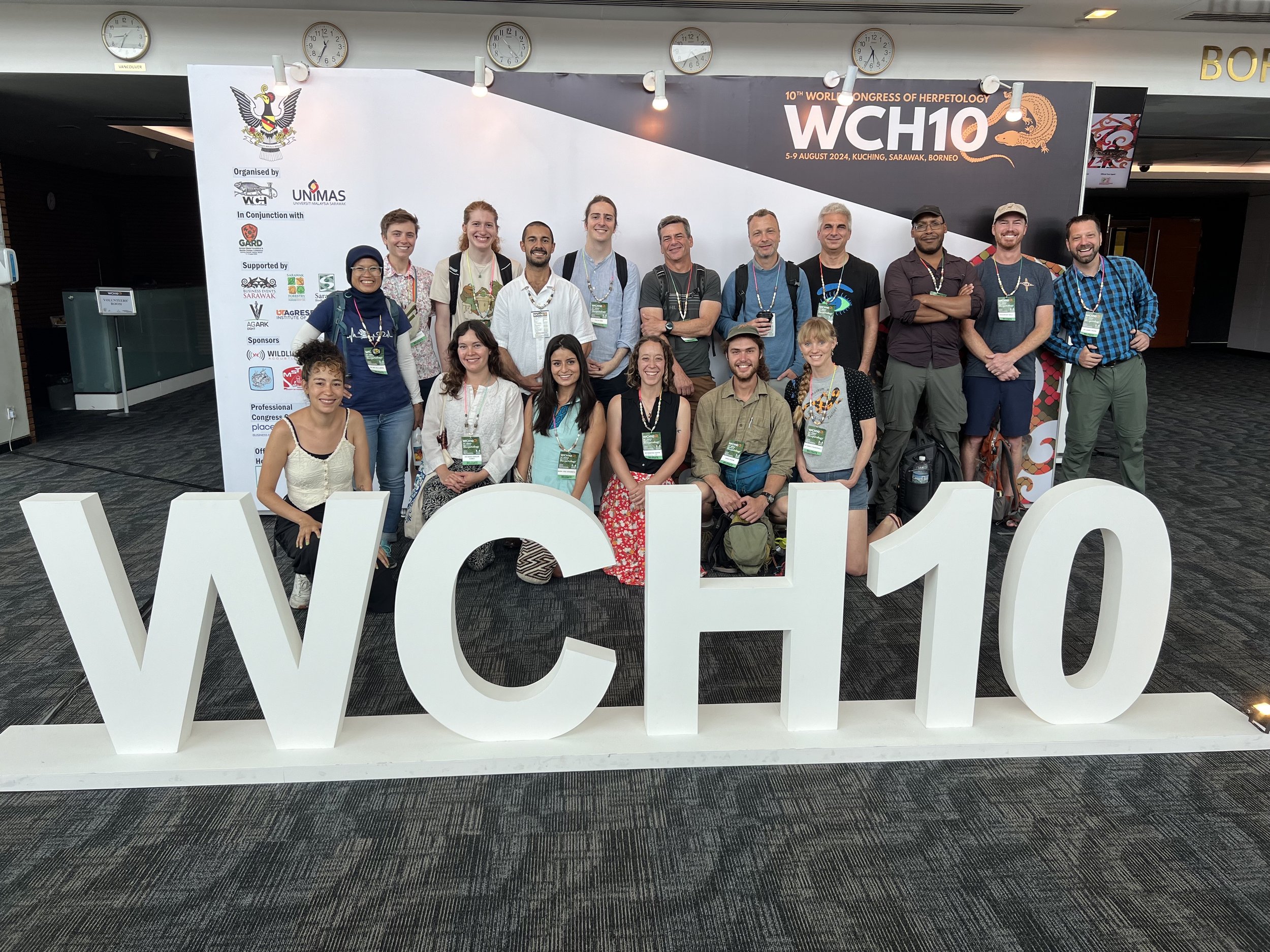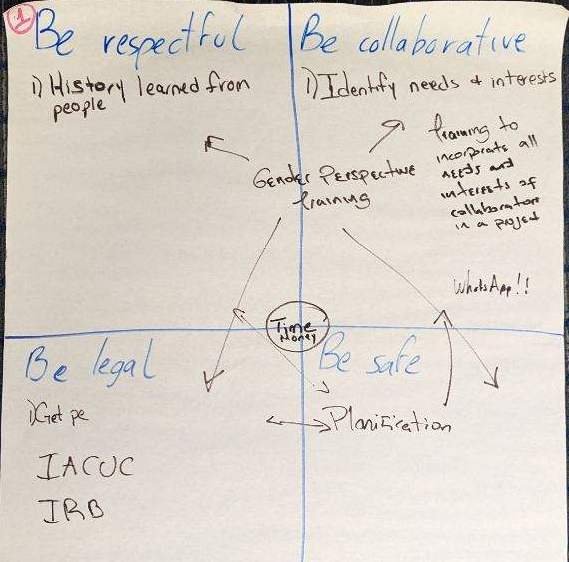We were
First up, some awards:
Majo has been awarded the Philomathia Graduate Fellowship in Environmental Sciences! This is a prestigious fellowship for UC Berkeley graduate students, "Students are nominated to receive the award on the basis of their high level of academic distinction and exceptional promise." https://vcresearch.berkeley.edu/philomathiacenter/graduate-student-fellowship-environmental-sciences
Becca was elected as a councilor for the Society of Systematic Biologists. Her term starts in January 2025.
Conference updates
Becca, Kannon, and Natalie attended SSAR 2024. Kannon gave a fabulous rendition of his Turnin’ the frickin’ frogs gay talk. Natalie presented a poster on her senior research project. Becca presented on a paper currently in review about passive accumulation of alkaloids in non-toxic poison frogs.
Becca, Kannon, Valeria, and Majo are heading to WCH 10 in Malaysia in 2 weeks.
Personnel updates
Sophie Draper started as our new lab technician. Sophie just graduated from Carleton College in Minnesota. She has experience with snail husbandry, fieldwork in Africa, people / project management, and research in genomics.
Nuzha Baksh said goodbye as she heads to Athens, Georgia to start a PhD.
We got two pet frogs for the lab (Dendrobates tinctorius). They were named Denny’s and IHOP after some disagreements about restaurant preferences arising from Kannon’s after-fieldwork dinners.
Adri Jeckel started in July as a new postdoc. She will be working on the toxic flies and poison frog projects.
Fieldwork
Becca went to Ecuador in May to gather samples for the NSF project on color in poison frogs, in collaboration with Santiago Ron. The field season was productive but the samples are still in Ecuador because airlines refuse to carry on the dry shipper. She also visited collaborators at USFQ including Juan Manuel Guaysamín who will be working this fall with Majo trying to cultivate tetrodotoxin-producing bacteria from Atelopus.
Majo traveled to Colombia for her final field season of the PhD to collect samples of a few species of Harlequin toads that live in the Sierra Nevada de Santa Marta. Working with Beto Rueda and his team she was able to obtain even more samples and species that she had hoped for.
Quickly wanted to highlight some of our lab’s publications this year:
Out in March, from a side project during my PhD and a collaboration with friend Anne Chambers: Chambers^, EA, RD Tarvin^, JC Santos, SR Ron, M Betancourth-Cundar, DM Hillis, MV Matz, and DC Cannatella. 2023. 2b or not 2b? 2bRAD is an effective alternative to ddRAD for phylogenomics. Ecology and Evolution 13: e9842. PDF • https://doi.org/10.1002/ece3.9842 • Twitter Thread (3/10/23)
Out in June, Kate Montana’s undergraduate thesis: Montana, KO, V Ramírez-Castañeda† and RD Tarvin. 2023. Are Pacific Chorus Frogs (Pseudacris regilla) resistant to tetrodotoxin (TTX)? Characterizing potential TTX exposure and resistance in an ecological associate of Pacific Newts (Taricha). Journal of Herpetology 57: 220—228. (Open Access) https://doi.org/10.1670/22-002 • PDF
Out in October, Yin Chen Wan’s undergraduate thesis: Wan^, YC, MJ Navarrete^†, LA O’Connell, LH Uricchio, A Roland, ME Maan, SR Ron, M Betancourth-Cundar, MR Pie, K Howell, CL Richards-Zawacki, ME Cummings, DC Cannatella, JC Santos*, and RD Tarvin*. 2023. Selection on visual opsin genes in diurnal Neotropical frogs and loss of the SWS2 opsin in poison frogs. Molecular Biology and Evolution 40: msad206. (Open Access) https://doi.org/10.1093/molbev/msad206 • PDF • Twitter Thread (10/21/22)
Out in November, a Tarvin lab collaborative review paper: Tarvin*, RD, KC Pearson*, TE Douglas, V Ramírez-Castañeda, María José Navarrete. 2023. The diverse mechanisms animals use to resist toxins. Annual Review of Ecology, Evolution, and Systematics. https://doi.org/10.1146/annurev-ecolsys-102320-102117 • PDF
Also out in November, a response to a commentary about specimen collection: Nachman, MW, … RD Tarvin, et al. 2023. Specimen collection is essential for modern science. PLoS Biology 21:e3002318. https://doi.org/10.1371/journal.pbio.3002318 • PDF
Valeria and I were recently invited to give a talk for the Helicopter Science series at the University of Florida. We presented our fieldwork equity paper and had a lively discussion with students and faculty across departments about how to rethink our approaches in field-based research.
Here are some of their thoughts:
Valeria and I enjoyed the subtropical climate very much.
Congratulations to Valeria! The WWF EFN program will support her during her final years of the doctorate program at UC Berkeley.
Valeria Ramírez Castañeda in Leticia, Amazonas, Colombia. Photo by Darío Alarcón
An excerpt from Valeria’s application:
Research and conservation of neotropical snakes is not only relevant but also urgent and timely in the face of the rapid deforestation rate of the Amazon rainforest in the last decade. The city of Leticia, located in the center of the Amazon rainforest, has 50,000 inhabitants of diverse origins who interact in different ways with nature, yet all of them encounter snakes in their daily lives. More than 30 species of snakes are commonly found in this city but at least a hundred live in the Central Amazon basin region, including at least three endemic species. However, it is estimated that millions of snakes are killed daily in Colombia, the main reasons being deforestation and intentional mortality by humans. Therefore, the urbanization processes in the Amazon and the city’s inhabitants are key players in the future of the rainforest.
Snakes are secondary predators and accomplish a key role in the ecosystem as frog, lizard, and small mammal consumers. Thus, studying snake interactions is fundamental to determining trophic networks in the rainforest. My main interest is to understand how reciprocal interaction between species can maintain and produce biodiversity in the tropics. Coevolution has traditionally been based on non-tropical models. For example, in my research topic, one of the best-known predator-prey models is the interaction between Californian garter snakes and their toxic newt prey. Although this model has revealed how resistance against a single toxin in a one-to-one species interaction arises, diversity in the tropics imposes new challenges. In the Colombian Amazon, more than 50 species of snakes species are feeding on frogs that secrete toxin cocktails. Thus, it is necessary to investigate tropical systems to understand coevolution in complex scenarios.
We posted our first two sets of translations from my Breaking Language Barriers Seminar. Check them out here.
Diaz et al 2006, Biodiversity loss threatens human well-being -- now available in Spanish and Chinese!
Arguello et al 2019, From genetics to biology: advancing mental health research in the Genomics ERA — abstract now available in Chinese, Spanish, Tamil, and plain language
Egido et al 2022, Mechanisms and clinical importance of bacteriophage resistance. now available: visual art summarizing concepts in the paper
Ehrenberg et al. 2021, Launching a saliva-based SARS-CoV-2 surveillance testing program on a university campus. Full article now available in Chinese. Abstracts now available in Chinese, Spanish, Tamil, and plain language.
Rabe et al. 2020, Post-hurricane shifts in the morphology of island lizards. Abstracts now available in Chinese, Spanish, Tamil, and plain language. Full article available in Spanish (email Becca for access)
Sidlauskas et al. 2021, Teaching ichthyology online with a virtual specimen collection. Full article now available in Chinese
Vernier et al. 2020, The gut microbiome defines social group membership in honey bee colonies. Abstracts now available in Chinese, Spanish, Tamil, and plain language.
Woodmansee et al. 2021, On-ranch adaptation to California’s historic 2012-2016 drought. Abstracts now available in Chinese, Spanish, Tamil, and plain language.
A blog co-authored by Rebecca and several colleagues about language barriers in science has been posted on the multilingual website Global Development Network. It is available in English, French, and Spanish.
And our new perspective piece is out now in BioScience: “Overcoming Language Barriers in Academia: Machine Translation Tools and a Vision for a Multilingual Future”. See the Press Release (English, Español)
See twitter threads in Spanish, Portuguese, and English
It was nice to see some folks in person!
Left to right, back to front: Connor Tumelty, Tyler Douglas, Inga Conti-Jerpe, Novia Keyfetz-Vuong, Becca Tarvin, Alfonso Fierro, Valeria Ramírez Castañeda
2 May 2021
It’s grant season…
Valeria was awarded a Tinker Field Research Grant from the Center for Latin America Studies at UC Berkeley
Valeria, Majo, and Tyler each received funding from the MVZ for summer research
Kannon Pearson was recognized by the Rausser College Dean’s Office of Instruction and Student Affairs Award Committee with the Kenneth L. Babcock Prize in Environmental Science for his outstanding research and outreach efforts. Kannon will be joining us as a new graduate student in the fall.
TBD was awarded an NSF PRFB and will be joining the lab in the fall. More information soon!
Sofia Beskind, currently an undergraduate researcher in the Matz Lab at UT Austin, will be joining us this summer to do research on Epipedobates, funded by an NSF REU grant that she received. Congrats Sofia!
NSF GRFP awards were announced this week & Tyler was recognized with an Honorable Mention. Congrats Tyler!!
Also this week, Valeria was recognized for her dedication to teaching with a prestigious Outstanding GSI Award. Congrats Valeria and thanks for your hard work!
Valeria successfully brought two snakes (on a plane) from the Amazon to Bogotá, Colombia, where she was able to obtain flash frozen tissues. Then she laboriously organized the export of the tissues to the USA (plane #2) while ensuring that they remain frozen, up until they arrived to the Vertebrate Genome Project lab this week (plane #3). We are so excited to process our first snake genome!
Meet Sandrita, the first of her species (Erythrolamprus reginae) to have her genome sequenced.
Valeria is currently in the Amazonian town of Leticia, Colombia, studying snakes that eat frogs. She will be conducting some difficult field research involving behavioral trials with several snake species. We wish her luck!
Valeria’s PLOS ONE publication was featured in an interview by Science Magazine yesterday. Read it here: https://www.sciencemag.org/careers/2020/10/science-s-english-dominance-hinders-diversity-community-can-work-toward-change
Her article has now been viewed >17,000 times!
Valeria’s new publication in PLOS ONE was highlighted by Berkeley News
Becca’s February Nerd Nite talk is now available on YouTube






























